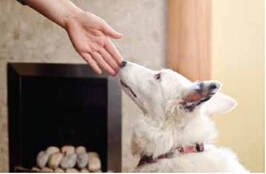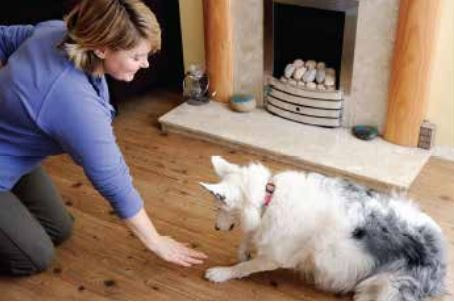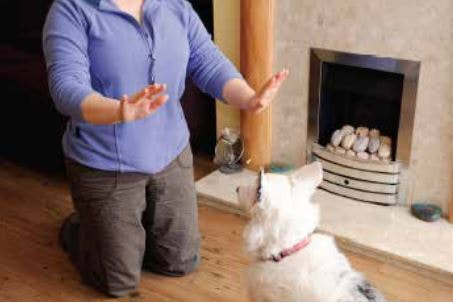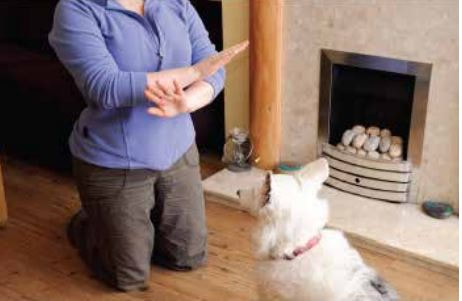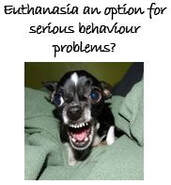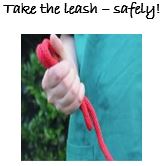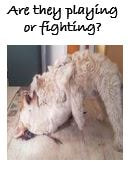Teaching Basic Sign Language To Dogs That Are Deaf
www.apbc.org.uk - a resource of really great articles
We may need to teach our dogs some basic sign language for several reasons: as they age many dogs lose some of their hearing, some dogs are born deaf, at a distance on a windy day it may be difficult for your dog to hear you.
Whatever the reason is, dogs naturally watch us for clues and often respond more quickly to body language than words.
The challenge is to:
a) choose simple, distinctive signs,
b) use the same signs consistently, and
c) reward your dog clearly when they get it right!
Using single hand signs generally makes it more practical but you can certainly get more complicated.
Recall is vitally important for dogs that cannot hear you – Barry Eaton’s book “Hear Hear” goes through this in detail, but until you are very confident please keep your hearing impaired dog on a harness and long line.
It is VERY important to use rewards-based hands off training with a deaf dog. Your dog should not be nervous of your hands or being grabbed, but keen to look at them and enjoy the training. If you must indicate displeasure a simple wag of the finger plus turning your back for a few seconds will be more than enough.
How to teach the signs:
1. Saying “good dog” First of all we need a simple sign that tells our dog “well done” – the easiest choice is a thumbs up (many people smile as well), make sure your hand is clearly visible to your dog. Make the sign and then deliver a small tasty treat (cubes of cheese are ideal).
If you want to use clicker training (sometimes called flicker training for deaf dogs) I suggest you have a basic ‘good dog’ sign that friends and family use as well as a more specific ‘clicker sign’. I use a starfish type sign starting with a clenched fist then stretching all fingers out to indicate a ‘click’. You can teach this just as you do with a normal clicker by pairing the sign with a treat. You can also use a small pen light to flash a marker but be careful not to shine it directly into the dog’s eyes
Whatever the reason is, dogs naturally watch us for clues and often respond more quickly to body language than words.
The challenge is to:
a) choose simple, distinctive signs,
b) use the same signs consistently, and
c) reward your dog clearly when they get it right!
Using single hand signs generally makes it more practical but you can certainly get more complicated.
Recall is vitally important for dogs that cannot hear you – Barry Eaton’s book “Hear Hear” goes through this in detail, but until you are very confident please keep your hearing impaired dog on a harness and long line.
It is VERY important to use rewards-based hands off training with a deaf dog. Your dog should not be nervous of your hands or being grabbed, but keen to look at them and enjoy the training. If you must indicate displeasure a simple wag of the finger plus turning your back for a few seconds will be more than enough.
How to teach the signs:
1. Saying “good dog” First of all we need a simple sign that tells our dog “well done” – the easiest choice is a thumbs up (many people smile as well), make sure your hand is clearly visible to your dog. Make the sign and then deliver a small tasty treat (cubes of cheese are ideal).
If you want to use clicker training (sometimes called flicker training for deaf dogs) I suggest you have a basic ‘good dog’ sign that friends and family use as well as a more specific ‘clicker sign’. I use a starfish type sign starting with a clenched fist then stretching all fingers out to indicate a ‘click’. You can teach this just as you do with a normal clicker by pairing the sign with a treat. You can also use a small pen light to flash a marker but be careful not to shine it directly into the dog’s eyes
|
2. Hand targets: teaching your dog to follow a hand target or a lure (piece of food in the hand). Offer your hand near to the dog’s nose and wait for them to touch it with their nose. Most dogs will do this fairly quickly out of curiosity! When the nose touches your hand give your “good dog” or “clicker” sign with the other hand, then deliver the treat asap. Repeat this exercise until your dog is confidently following your hand as you move it around. |
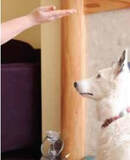
3. Something simple like SIT: once your dog has learned to follow your hand, taking a flat hand, palm upwards, in front of the dog’s nose and slowly moving your hand over the dog’s head (up and slightly back) should mean they lift their head and start to sit. Immediately give the “good dog” sign and reward.
|
Come – come back to me and wait for next instructions, as you do with a hearing dog by opening your arms and encouraging them back to you, this wants to be a big signal to be seen at a distance Wait – stay in one place until I ask you to move, often taught using a flat hand with the palm facing the dog |
|
Give – release what is in your mouth, could be a closed fist (which has a treat in it when training initially) or a suitable sign from a sign language dictionary
Finished – for example when you have been playing a game or training, both hands facing the dog with crossed wrists, separate your hands in an ‘all done’ gesture |
Extra resources:
Barry Eaton’s short booklet “Hear Hear” available from online booksellers
The DDEAF (Deaf Dog Education Action Fund) website and resource centre - USA based but very accessible and fantastic information, also sells bandanas to alert people to your dog’s deafness. http://www.deafdogs.org/
The Deaf Dog Network (UK) Facebook group and website
Any on-line sign language dictionary – great for getting ideas for signs and seeing the visual of how
to move your hands. My favourite is: http://www.aslpro.com/
Barry Eaton’s short booklet “Hear Hear” available from online booksellers
The DDEAF (Deaf Dog Education Action Fund) website and resource centre - USA based but very accessible and fantastic information, also sells bandanas to alert people to your dog’s deafness. http://www.deafdogs.org/
The Deaf Dog Network (UK) Facebook group and website
Any on-line sign language dictionary – great for getting ideas for signs and seeing the visual of how
to move your hands. My favourite is: http://www.aslpro.com/
|
Pet owners can be faced with making the emotional decision of euthanasia due to their pet’s behavioural issues, namely serious aggression or anxiety disorders.
|
So many of us make these simple mistakes not even realizing it. This can result in confusion for the dog and even injury to the handler
|
If two dogs are wrestling and it seems too rough to you, with all that growling and snarling, body-slamming, and biting of each other’s necks, should you intervene? Can you tell the difference between playing and fighting?
|

